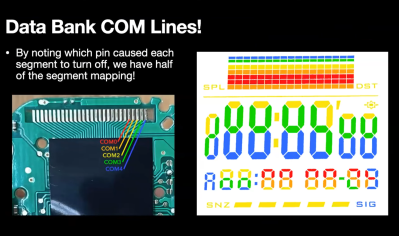Segmented liquid crystal displays are considered quite an old and archaic display technology these days. They’re perhaps most familiar to us from their use in calculators and watches, where they still find regular application. [Joey Castillo] decided that he could get more out of these displays with a little tinkering, and rocked up to Remoticon 2021 to share his findings.

Segment LCDs are usually small monochrome devices made out of glass, that have the benefit of using very little power in their operation. They come with a fixed layout, which cannot be changed – so they’re often designed specifically for a given purpose. A calculator will have segments laid out to display numbers, often in the usual 7-segment fashion, while a watch may add dedicated segments for displaying things like “AM,” “PM,” or “ALARM.”
Their purpose-built nature means they’re often very thin and compact with useful layouts that are attractive and fitting for their given applications. Compared to general purpose LCDs, like the popular HD44780 character LCDs, they often have much cleaner aesthetics and a sleeker design as they’re meant to be consumer-facing, rather than used in any one of a million different industrial applications.
[Joey’s] talk starts off with a primer on how segment LCDs work, initially comparing them to 7-segment LEDs that so many of us are familiar with. However, LCDs are a little different in their operation, with segments darkening when a voltage differential exists, and are driven with AC signals rather than DC. [Joey] explains how to drive LCD segments in this manner, providing a CircuitPython example that demonstrates how its done.
Multiplexing is also described in detail, a technique used in many segment LCDs to allow them to be driven with less IO pins. Scoping out the LCD pins on a standard Casio F-91W wristwatch shows how the technique works, and it’s easy to follow along seeing the signals displayed clearly on an oscilloscope. [Joey] also explains that generating all the signals needed is easy if you just go out and purchase a microcontroller with an integrated segment LCD controller, like the Microchip SAM L22.
As a primary example of what can be achieved when hacking segment LCDs, [Joey] shows how he repurposed the display from the Casio Databank DB-36. The LCD has 55 connections and tons of segments, and is hooked up with zebra strips – a rather delicate method of connecting a segment LCD. Using some sticky tape, he blocks out a pin going to the LCD, reassembles the watch, and looks for which segments don’t work anymore. This technique allows the pinout of the display to be quickly mapped out.
Obviously, though, if you’re reverse-engineering a display, you’re limited to using the segments as laid out by the original designers. As [Joey] happily explains, though, you can actually get your own custom segment LCDs made without too much bother! He’s already done it himself, creating a dupe to match the Casio F-91W in a Feather-compatible form factor to ease development of the Sensor Watch board. There is a quantity requirement, but you can end up spending less than $1 per unit on big orders.
While segment LCDs are old-school and basic, they’re still a great technology for any low-power project that needs to display some data. After all, just think about how long the average digital wrist watch can last on a single coin-cell battery! [Joey]’s talk is a great primer if you’re interested in taking advantage of these displays, whether in existing hardware or by getting your own made from scratch!














At first read, I thought this was pretty much of a niche hobby, but I suspect there are quite a few people in to watch design/repurposing based on the number of write ups we see on HAD about watches. Kudos to [Joey] and the article.
That is one beefy MCU for such a small job! Best of luck to this project.
That “period-appropriate oscilloscope” is very modern to me. So he must be kidding, right?
Even has some sort of computer build-in!
My father’s oscilloscope is a Hameg HM-312.
That’s what I call an ordinary oscillosco.. -err- oscillograph! 😃
A vintage oscillograph would be my humble old Trio/Kenwood CO-1303A/D.
I thought an oscillograph displayed on paper, rather than a screen.
I am vaguely aware of seeing the term, but it sure wasn’t used instead of “oscilloscope” in North America in the past fifty years. Actually earlier, since I have a lot of hobby electronic and ham radio magazines from the sixties and fifties
Hi there! Yes, that’s correct, I think.
The original paper device used some sort of pen.
Here in Germany, though, the oscilloscope (Oszilloskop) used to be called by the old name, Oszillograph/Oszillograf, as well.
That’s where the nick name “Oszi” (der Oszi) came from. It’s an equivalent to the English “scope”, I think.
I think the whole idea comes from imagining the electron beam “writing” on the screen, so “Oszillograph” as the primary term stuck up until the late 1980s.
– In West-Germany, at least.
People in GDR perhaps called it differently, not sure. 🤷♂️
To “us”, they always seemed to use strange terms or terms that are more German than German, btw. 😃
Say “Buntfernseher” or “Farbfernsehgerät” , while in the west, people rather just casually said “Fernseher”. Anyway, each to his own. Some diversity is good, also.
In practice, both terms are in use synonymously, but my/the younger generation (30 and below) seems to just say oscilloscope/Oszilloskop nowadays.
I love what he did with the Casio F-91W! Very cool way to add features to the classic, without ruining what_made_ it a classic in the first place :-)